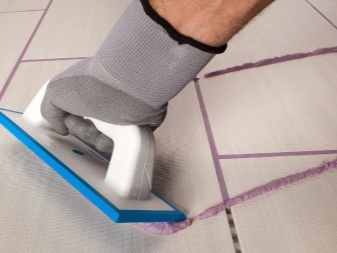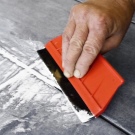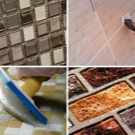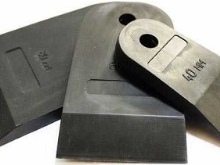Types of grout spatulas and their use

The inter-tile gaps obtained during the laying of tiles require a high-quality grout, which brings an aesthetically complete look to the coating. For high-quality performance of work, it is important to use appropriate devices - spatulas for grouting. Otherwise, the work will turn out to be unsuccessful.


Peculiarities
The trowel for grouting joints in the inter-tile gaps differs from other manufactured analogues. It is made of technical rubbers or rubber, equipped with special sharpened edges. A high level of plasticity of such a product:
- simplifies the implementation of the trowel process in inconvenient areas;
- significantly reduces the likelihood of damage to a thin tiled coating;
- facilitates even distribution of grout without much effort.
The dimensions of the blade of such a tool vary in the range of 4-80 cm, which makes it convenient for different working areas. Oversized products allow you to work on large areas, and small ones are used to process inconvenient areas and corners. The spatulas are supplied with practical wood or plastic handles. A competent design solution and plasticity of the product contribute to the high-quality placement of the consistencies used.
There are also spatulas without handles, they are intended for operations in niches, corners and more difficult places.


Although the discussed tool is structurally simple, it does not follow that any of its varieties will be convenient and practical in various conditions of use. In other words, not every variety is capable of facilitating the processing of joints, but only one that satisfies two requirements.
- The rubber cloth is quite dense and plastic, it can easily not only close the seams, but also remove the remnants of the compounds from the tiles, it has tapered edges that press the grouting material into the corners. If the cleaning of excess composition is not completely carried out from the coating, they will fall into the porous body of the tile, and a composition that is poorly compacted at the joints contributes to the occurrence of cracks.
- The handles must be exceptionally ergonomic and comfortable to work for a long time and without fatigue in the hands.
They should promote productive pressure for high quality compaction of consistencies. Otherwise, bubbles form, reducing the beauty and reliability of the seams.

When are they needed?
Rubber fixtures are widespread in the implementation of repairs and are often used:
- for grinding seams and parquet joints;
- for cleaning the excess of the used compounds;
- in restoration work for cleaning mosaics;
- for processing clinker masonry and decorative bricks;
- for aligning tile gaps;
- for applying cement and epoxy mixtures.
If you do not heed the recommendations, but use spatulas for painting or plastering operations, then stripes or other defects will appear in the treated places. Usually, fixtures of various sizes are used, focusing on the parameters of the tile.
Spatulas are often sold in kits containing small, medium and large pieces. The prices for them are budgetary, so the tool belongs to consumables.






Views
The types of spatulas are diverse, they differ according to several criteria.
- According to the shapes of working blades, which are made in the form of trapeziums, rectangles, with oval sides and in a wedge-shaped version. The most popular are trapezoidal products.


- Available in white and black colors. Their color carries a certain meaning - it indicates the degree of rigidity of the instrument. White products are characterized by softness, and they are used in the final stages of work on joints and seams. Black, with greater rigidity, it is more convenient to compact the compositions without forming unwanted voids.



- By types of handles. Experts consider handles-staples to be the most ergonomic, but they are more expensive. With small fronts of work performed at home, an inexpensive product with a trapezoidal plastic handle is quite enough. Accessories are also sold with wooden handles, but they are not entirely comfortable.

Some kits contain narrow round rubber spatulas for joining only. Spatulas with rubber, rubber and silicone sheets may look similar in appearance, and therefore, when buying a product, this issue should be clarified.
Both the quality and the service life of the tool largely depend on the material. Rubber products are versatile, more durable, resistant to chemicals and waterproof. Rubber - rather susceptible to wear and tear, quickly deteriorate, and can decompose.



Soft planning
These devices are made of rubber or rubber, with rigid handles and main edges 3-5 mm (length 25-60 cm). On the main side there is a chamfer (45 °). They are available in different forms. This is a trowelled version of trowels used in the course of tiling operations with large tiles or mosaic elements with the use of cement. The device obtained from latex has become more expensive, but it has a short service life.

Painting rubber
Painting devices are produced in rubber (light) or rubber (black), 3-5 mm thick, with edges 10-25 cm. Black ones are hard, which contributes to a denser filling of the joints. Rubber variants have a longer service life - rubber is stronger and more durable than rubber and is less prone to cracking. It is simple to check the quality of the rubber - the plate should be bent, and it should instantly return to its original state.
Spatula handles are made of wood or plastic, and in shape they resemble the handle of a brush. They are triangular or trapezoidal. The handles are positioned at an angle of 45 ° or 90 ° to the main edges of the products. Spatulas are used for rubbing difficult reliefs, for example, with uneven bases.
With its medium dimensions, this type of spatula has become universal, since it is productively used for the processing of mosaic surfaces and when filling joints between tiles.


For filling tile joints
The seams are usually filled with trapezoid and triangle-shaped spatulas, with the main edges measuring 5-10 cm. The fixture plate is fixed in wooden or plastic handles. These devices are small in size, they are convenient for use in difficult places. As an option, they also exist without rigid handles. In section, they are made in wedge-shaped shapes (made of rubber or rubber) or with chamfers on the main edges.
Rubber spatulas are used during operations with ceramics, when filling cracks and joints of various finishing materials. Sizes are selected according to the size of the tiles, and the stiffness is determined by the parameters of the seams - the deeper they are, the harder the plate is taken.

Joining
This toolkit is used not only for grouting seams, but also for the formation of profiles and reliefs. Initially, the seams are filled with a grouting consistency with other types of spatulas, and then a form is created with a jointing device, and the consistency is compacted. They are also used for the production of round seams.

How to use?
For the successful use of spatulas, it is important to choose them correctly, they must have:
- a well-sharpened canvas, rubber products are not worth buying;
- a satisfactory degree of rigidity corresponding to the material with which you will have to work;
- an ergonomic handle (if it is a tree, then it must be treated with drying oil);
Among the leading brands for the production of rubber spatulas, we note the firms "Zubr", FIT, Sparta, Stayer, which offer users the most ergonomic, high-quality and versatile devices. The basis of the tools remains technical rubber, which can sharpen perfectly. In production conditions, the edges of the canvases are simply cut at a predetermined angle. Thanks to this tool, it became possible to carry out work on areas of varying complexity, with reliefs of various shapes on the walls. Types of devices without handles are used when rubbing cracks, openings, joints and others.

Plastic and flexible products are applicable when working with the seams of tiles, natural and decorative stone, ceramics, flooring at the joints of linoleum. With their help, puttying operations are not carried out, structurally they are not designed for this type of load, however, as well as the handles. According to experts, the grouting process carried out with rubber spatulas is one of the most convenient types of work. It boils down to two dominant movements: placing the mixture with a spatula in the seams, removing excess from the surfaces. In this case, the instrument must be kept dry, since even a small drop of water leads to the dissolution of the mixture to be rubbed, as a result of which it soon dries up and loses its condition.
Thanks to the joining operation, the surfaces are endowed with external elegance. The operation is carried out with the rounded side of the tool, in other versions it is done with a handle or an independent device. Rubbing should be done after the tile adhesive is 100% dry. Remains of dry grout are removed with a cleaned or new rubber tool. Moreover, it is placed perpendicularly.
Strong pressure on the trowel should be avoided so as not to spoil the finished seams. As an auxiliary option for removing excess solution, use a special foam rubber grater.


How to care?
Usually, spatulas are treated like consumables because they are inexpensive. However, in order to extend the service life, they need care:
- regularly clean the spatula plates after finishing work from contamination with building and grouting mixtures;
- check them for cracks that reduce the plasticity of rubber products, since solution can accumulate in the cracks;
- the edges of the devices should not have defects and notches, which reduces the level of productivity of their use;
- to preserve the performance of the spatulas, the deformed edges are cut off;
- if the spatulas are stored in containers with other tools, the rubber sheet may bend, as a result of which it will become unsuitable for correct use.
Rubber fixtures should be used with caution with epoxy based grout and a cellulose sponge should be used to remove residues. Do not expose the spatulas to rough mechanical stress, and they should only be stored in an upright position.
Careful use of tools and proper care of them help to increase their service life.















The comment was sent successfully.